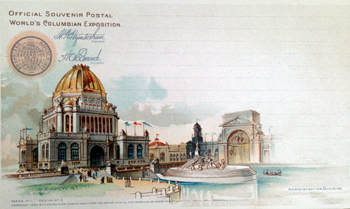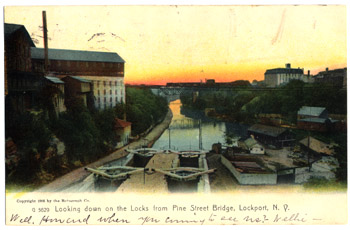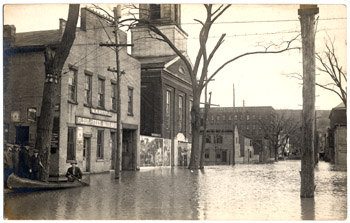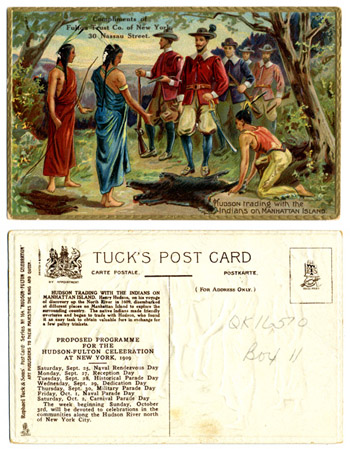Wish You Were Here!: The Story of the Golden Age of Picture Postcards in the United States
by Fred Bassett, Senior Librarian, Manuscripts and Special Collections

Picture postcards in the United States began with the souvenir issues sold at the World Columbian Exposition in Chicago in 1893. The hobby of postcard collecting began soon after and continued unabated until the beginning of World War I. With that event, the postcard album, a book second in importance only to the family Bible, suddenly vanished from the parlor.
The Columbian Exposition cards proved to be so successful, that publishers in other parts of the country were emboldened to issue views featuring large cities, historic landmarks and popular vacation resorts. Like the exposition cards, these were also well received, despite the fact that the federal government subjected them to the full-letter postage rate of two cents while government-issued postals could be mailed at one cent. Public demand to use privately printed postcards became so great by 1898, however, that Congress granted a concession and lowered the postage rate to a penny. After 1898, the postcard industry was off and running, and so was the hobby.
Postcard collecting had become widespread in Europe by the turn of the century. By 1905 it had reached comparable proportions in the United States. The enormous growth of the postcard craze in this country, within so few years, can be attributed to many factors, including a shift in tastes of the American public from sentiment to modern art, and the development of a sales and distribution network of jobbers and importers that linked German printers with small town merchants (who wanted to immortalize Main Street on viewcards) and retail outlets, such as drugstores, bookshops, newsstands, and department stores, which strongly promoted the sale of postcards, since they required small amounts of display space and bore a good profit. The initial souvenir cards of vacation resorts and big cities gradually evolved into diverse lines, which included viewcards, comics, holiday greetings, and advertising. This diversity placed postcards within the means and interests of almost everyone.
The decade between 1905-1915 – the Golden Age of Postcards – saw postcard collecting reach a zenith of staggering proportion. Literally millions of postcards were printed, imported, sold and mailed. Official U.S. Post Office figures for the year ending June 30, 1908 revealed that approximately seven hundred million postcards had been mailed in this country. By 1913 the total number mailed had increased to over nine hundred million, and, by this date, the craze was reportedly on the decline!
During the heyday of the postcard craze people bought them for the simple pleasure of owning them. They preserved the cards carefully in albums or posted them to friends and relatives, with the expectation of receiving many in return. In essence, postcards served as an inexpensive form of entertainment in almost every American home, just as radio and television were in later eras. Visitors often viewed with delight the heavily padded postcard albums adorning parlors, living rooms, and sun porches. Postcards were so ubiquitous that a person could not visit any sizable town, without seeing them in almost every store window – either for sale, or for the sheer delight of sharing a view. In turn, postcard publishers endeavored not only to sell cards embracing a variety of subjects, but also tried to provide for the public a postcard of charm and originality, often superbly colored and even embossed.

a 1906 postcard from the Rotograph Co.
In the hand-written message at the bottom,
Nellie asks "Well, Howard, when you coming to see us?"
At first postal regulations permitted only the name and address of the recipient on the back, so by necessity, messages defaced the illustrated side. In 1907, however, the Post Office Department relented. The back of the postcard could be split down the middle to provide space for both correspondence and address. This epochal decision saved the picture, unless, of course, someone chose to mark an "x" over a hotel window or whatever. The additional message space enhanced the use of postcards for communication at a time when people traveled less frequently, telephones were few, and the postal system was quite efficient. Greetings were often posted December 24 for Christmas and January 1 for New Year's Day. Cards were frequently mailed ahead to announce a family visit or sent as an invitation to friends for parties. Much of the news conveyed was trivial and mundane, the exact sort of detail that makes up the day-to-day life of humanity today. Progress or decline in the state of health of relatives was meticulously chronicled; cards were sent to convey news of death and birth, purchases at stores, church activities and employment. In other words, to the general public postcards provided a convenient way to keep in touch with friends and relatives, without the burden of extensive writing. The postcard industry promoted this point as much as literary critics decried it. To some the fine art of letter-writing appeared threatened with extinction.


"Hudson trading with the Indians on Manhattan Island,"
created for the Hudson-Fulton Celebration in 1909.
Publishers and Printers
To supply the insatiable demand for postcards, publishers sprang up like wildflowers. Frequently, they had their pictures printed in Germany, where lithographic techniques were superior and painstaking workmanship was very cheap. One of the most famous names in the postcard trade was the Detroit Publishing Company, with almost sixteen thousand views taken by its photographers, who traveled all over the country. Most of their cards were models of color, composition, and meticulous detail. A firm which rivaled Detroit for quality during the height of the postcard craze was the Rotograph Company in New York City. The quality of its gravure style views was exceptionally high. The leading English firm, Raphael Tuck & Sons, exported many delightful cards for the American market. They usually issued their cards in sets of six, and were notorious for the extent to which they retouched photographs. Edward Mitchell, the largest western company, and other large publishers, such as L.J. Koehler (famous for its hold-to-light cards), American News Company, Hugh C. Leighton, Samuel Langsdorf, International Art Company, Illman, and Winch also marketed very attractive postcards. The German publisher, Stengel, and the Italian firm, Sborgi, set the picture postcard standard for reproductions of fine art.
The large publishers, however, did not always penetrate the small towns with their photographers. So the local druggist, stationer, department or novelty store sent photographs or negatives to Germany to be printed as postcards. Hence the name of some obscure druggist appears frequently as the publisher. The German printers, in fact, retained agents in large cities to facilitate orders. A New York City firm advertised to "make postcards exclusively for you from any size photo or print you send us, deliver them in ten days' time, guarantee not to use your subjects for anyone else, and put your name on each one as the publisher." Prices were quoted at five hundred cards for four dollars and a thousand for six dollars.

German printers dominated the postcard manufacturing business until 1909, when the enactment of the Payne-Aldrich Tariff effectively cut off low-cost importation of postcards, along with many other goods. Although American printers and publishers had strongly promoted the tariff to protect and develop the postcard trade in this country, it ironically did just the opposite. The tariff and a combination of other factors, eventually contributed to the demise in the postcard's popularity, and ultimately sounded the death knell for the postcard industry in America. The most noticeable effect of the tariff was the gradual deterioration in aesthetic quality of the pictures and art work. American printers did not possess the advanced technology to match the high quality of German lithography. There were a few exceptions, of course, like the Detroit Publishing Company. But in general, the standards had clearly declined after the tariff, and as a result, people began to lose interest in postcards.
On the other hand, following the enactment of the Payne-Aldrich Act, firms such as the Cargill Company of Grand Rapids, Michigan, began to issue cards. Jobbers and importers, however, anticipating the tariff, made a concerted effort to stockpile German cards. Every link in the chain was overloaded. importers overloaded jobbers, jobbers overloaded retailers, and according to Orville Walden, "every rack in the country was loaded." Most retailers were faced with a year's supply of cards. In an effort to move stock, price cutting began. cards which sold two for five cents became three for five, then a cent each, and even ten for five cents. Without fresh stock, dealers began to lose interest and turned to more profitable lines.
In an attempt to correct unfair practices, price slaughtering, and stores filled with unsalable cards, the National Postcard Association was formed to stabilize the industry. However, in 1912, F.W. Woolworth released for sale, through its chain of stores, millions of postcards to retail at ten cents a dozen. In the same year, trade papers announced the introduction of French-fold style greeting cards, with envelopes to retail at five cents each. By 1913 vast numbers of folded cards were being stocked in retail outlets, and postcards had to be unloaded to make space. One western publisher advertised two million views of the United States at half their production cost. Unsalable cards reached an all-time low price of five cents a dozen on retail racks. Fifteen American publishers ceased production during 1913, while several others went into the greeting card business. One last effort was made that year to recapture the market with unusual novelty items, wire tails, phonographic records, and mechanicals. But the fascination of postcards had passed. The outbreak of World War I in August 1914 shifted people's minds away from fancies like postcards to more serious matters. The same year, the postcard manufacturers cancelled their annual conventions due to lack of interest. By 1915, trade journals omitted discussion of postcards entirely. The Golden Age of Postcards had passed.